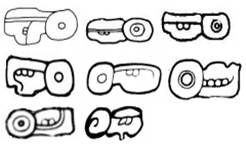![]()

![]()
![]()
![]()
K&H.p86.#7 K&L.p22.#5 TOK.p9.r2.c6 BMM9.p10.r7.c4 JM.p228.#4
TE’ TE’ TE’ TE’ TE’
![]()
JM.p228.#5
TE’

![]()
![]()
K&L.p22.#4.4-6 TOK.p13.r2.c4 JM.p229.#1
TE’ TE’ TE’


TOK.p32.r2.c3 BMM9.p21.r2.c2
TE’ TE’
![]()
![]()
![]()
JM.p229.#2 JM.p229.#3 JM.p229.#4
TE’ TE’ TE’
![]()

![]()
![]()
K&L.p22.#4.1&2&3 TOK.p32.r2.c4 JM.p230.31 BMM9.p21.r6.c1
TE’ TE’ TE’ YET
![]()

![]()
![]()
K&L.p23.#1 TOK.p25.r1.c4 BMM9.p14.r7.c4 JM.p230.#2 = 25EMC.pdfp46.#8.1
TE’ TE’ TE’ TE’ TE’

25EMC.pdfp46.#8.2&4
TE’ (25EMC.pdfp46.#8.3 is not TE’, should be “UHMAN”)


Nuckols-SGaFF.p18.pdfp11.fig4b (Schele) = Montgomery
CPN Stela D A5
<9+TE’>.<IHK’:SIHOOM>


ZenderEtAl-SSw.p43.pdfp9.fig8 Boot-ANNAT.p40.c1.fig2 (Boot after Reents-Budet)
FLD alabaster bowl E K4669 B3
TE’ <ja:wa{n}>.TE’
· Variants (5):
o A. Axe – long, rectangular outline – features:
§ Washer.
§ Axe-blade with internal reinforcement on the long and outside edges, with 2 touching dots.
o B. Boulder – features:
§ Asymmetric cave with reinforced ceiling.
§ Curved vertical band (sometimes just line).
§ 2 touching dots at half-height, on one side (the side which curves out).
o C. Axe + Boulder: Axe variant on top of Boulder variant.
o D. CH’ICH’-like / “JELLYFISH”-like (though probably related to neither of them):
§ Optionally, above the top – a hand-like element:
· Left: (optionally bold) left feeler with protector.
· Right: hand with fingers.
§ Top: (optionally bold) inverted lipped-U ceiling.
§ Bottom (the “wood property marker”):
· Curved vertical band (sometimes just line).
· 2 touching dots at half-height, on one side (the side which curves out).
§ Do not confuse this with “MIJIIN”. They don’t really resemble one another that much:
· This one has two indentations about 1/3 and 2/3 of the way along the bottom (“CH’ICH’-like” / blood-cartouche), which “MIJIIN” never has.
· “MIJIIN” has an AJAW-face in the centre, which this one never has (instead it has the “wood” element).
§ Interestingly, BMM9.p21.r6.c1 lists it as a separate logogram, pronounced YET (with no question mark). Perhaps there has been some convincing recent research which argues that this glyph – which has long been seen as a variant of TE’ – is in fact a different logogram.
o E. Head – also referred to as the Pax God, Paax God, Pax Deity:
§ Eye: a large squarish eye:
· Note that 25EMC.pdfp46.#8.3 is not TE’ but “UHMAN”:
o The eye is not square and it has a scroll inside.
o The mouth region has two large and distinct scrolls , one going left and one going right.
Both these characteristics are typical for “UHMAN”.
§ Mouth: a CH’AB-like element.
CPN Stela D A5 is the head variant interacting with a full-figure variant of the number “8” (IXIIM = “maize”, with corn husk and kernels in the head), forming the Haab date of a CR: 8-TE’-IHK’-SIHOOM = “8-Ch’en”.
§ Nuckols-SGaFF.p19.pdfp12.para1: Another key decision was made in block A5 [of CPN Stela D], where the first head variants occur.in this inscription [of otherwise full-figure glyphs]. (Figure 4b) Here the maize god Ixiim sits as a full-figure glyph for the number 8, holding the head variant for the logograph TE’. These two signs together spell waxakte’, meaning “eighth” and referencing the 8th day of the month Ch’en. Visually, these two signs reference growth, fertility, and trees: the maize god represents the life cycle of the maize plant itself and the associated abundance and life that corn brings, while the head variant for TE’ represents the “Pax” tree god—a personified tree embodied by a face that sits at the base of mythical trees with roots growing from the jawless bottom half of its mouth. Although the maize god was the scribe’s only choice for personifying the number 8, the decision to include the TE’ head variant seems intentional—the inclusion of the suffix -te’ after waxak (“eight”) appears to have been optional to scribes. Furthermore, in other full-figure texts that include TE’, the scribe frequently conflates the TE’ sign’s flowing roots with the face of the associated number, creating a leafy beard. The choice to isolate this sign as a head variant draws the reader’s eye and visually reinforces the theme of trees and leafy growth associated with forests and trees—an aspect also associated with stela[e?], as will be discussed below. In addition, the theme of severed heads growing from trees finds parallels in the Maya myth in which the Maize God is decapitated in the Underworld, and his head is hung from a calabash tree.
· ZenderEtAl-SSw.p43.pdfp9.c1.l-11: itz’in te’ [itz’in] taaj […] “junior trees and junior obsidians.” […] This is almost certainly a reference to members of a ranked ritual order of priest-scribes.